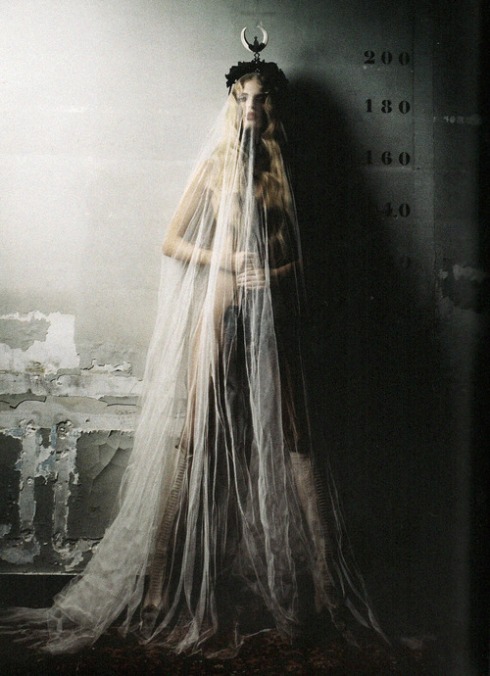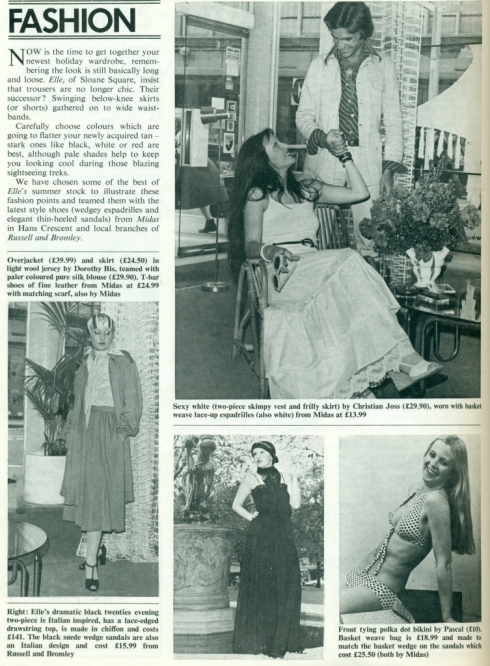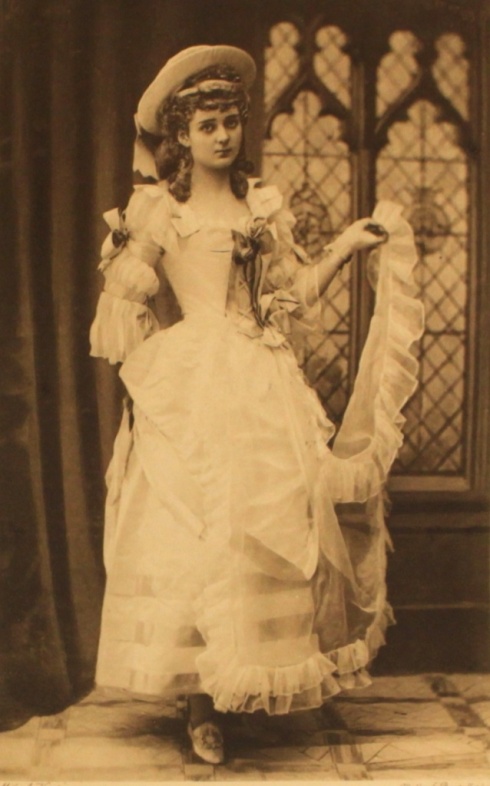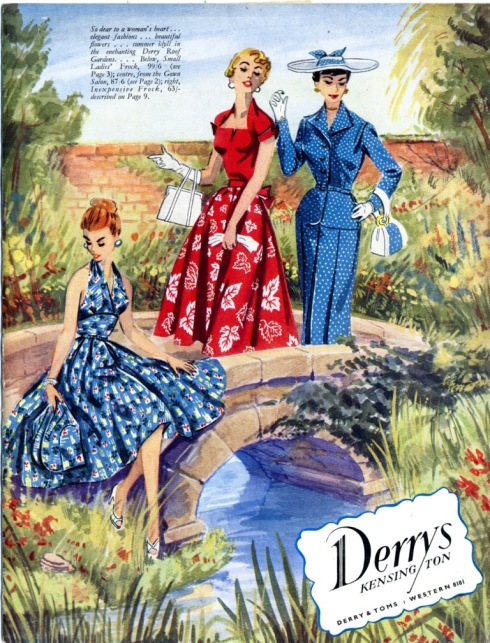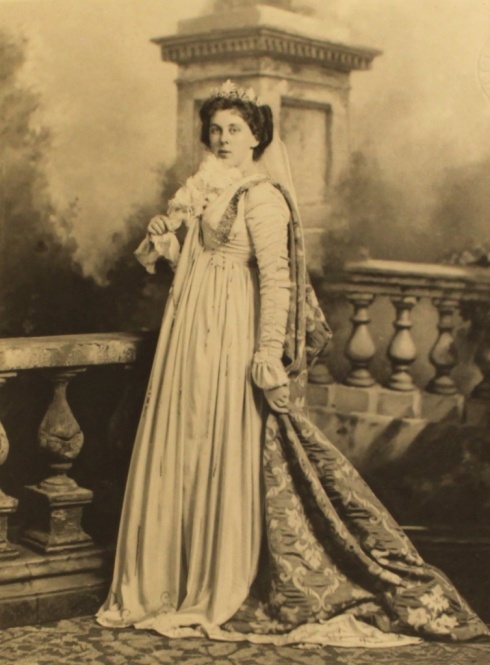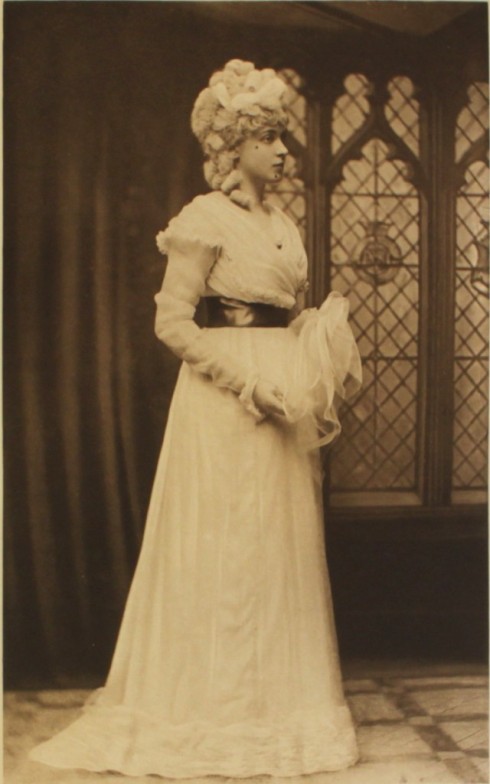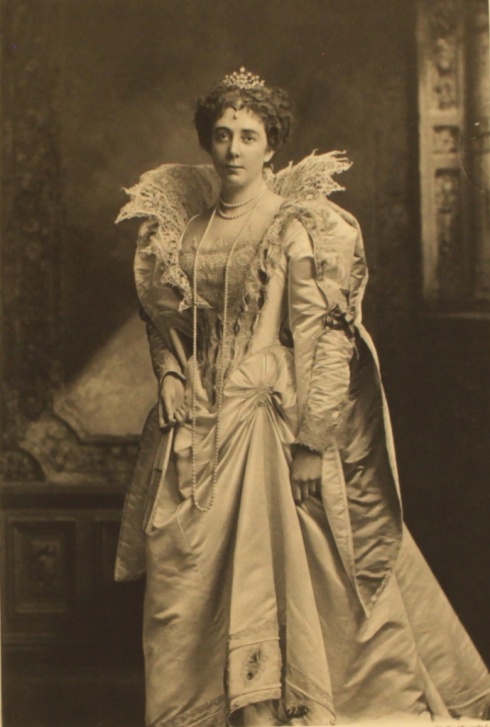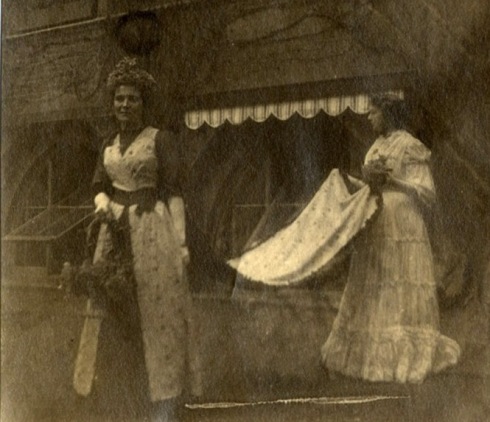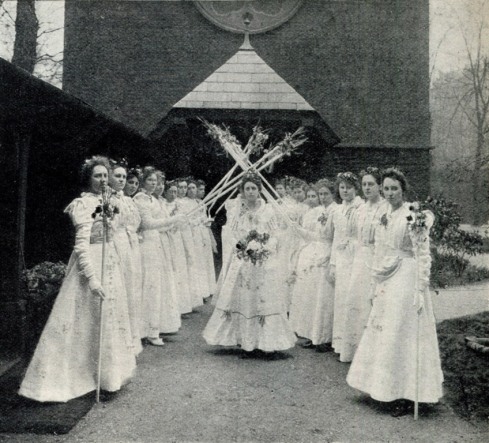I’ve wanted to find a good reason to come back to Clementina, Lady Hawarden and her brief career exploring costume, fabric and light within the confines of a few rooms in her house at Princes Gardens. I only recently thought of an obvious way to look at her work as a fashion photographer as I suggested she was in my first post about her.

Here, in the room with the starred wallpaper, her daughter and principal model Clementina Maude, an elaborate dress draped around her adopts a pose which shows off the way the material falls over her body. You want to call the pose langorous or thoughtful, which is the impression it gives, even though you know the young Clementina had to hold the pose for several minutes while the plate was exposed. Although the photograph has suffered over the years you can still see the contrast between the side directly lit by the light from the window and the greater detail visible on the other side.
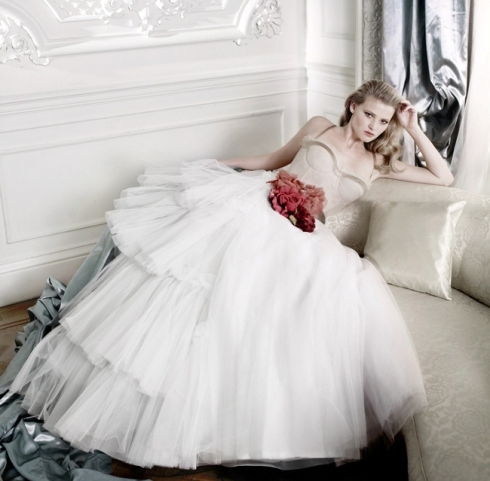
The light is falling from the other side in this picture by one of the modern masters of fashion photography Mario Testino and although the shutter speed was measured in seconds rather than minutes the same care has been lavished on the model’s pose and the way the dress hangs.
It may have been the search for available light that drew Lady Clementina to the windows of her improvised studio but she comes back to them repeatedly.

Clementina again in some kind of fancy dress, Bohemian or gypsy perhaps, steps through the shutters from the balcony.
Below, a model negotiates a more complicated arrangement of wooden screens and windows in an equally sparsely furnished 19th century room.
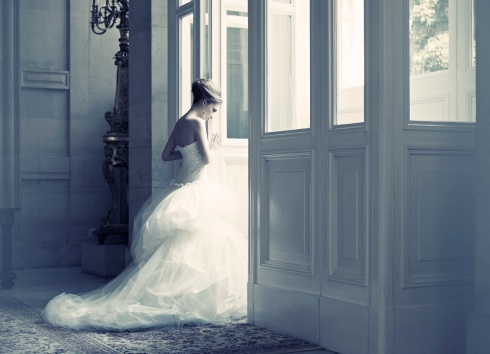
She has the same attitude of trepidation in this picture from a calendar for the Polish Embassy in Paris by Piotr Stoklosa.
Lady Clementina’s other favourite prop was a mirror.

As she knew Lewis Carroll (he visited the house and bought several examples of her work), you might want to start on Alice and Through the Looking Glass (not published till after Lady Clementina’s death) and soon there would be several sentences devoted to modern fantasies about the Victorian period. You can do all that yourselves quite easily. I’ll just stop for a while and listen to an album. I’ll pick something non-Victorian like Can, or Wire
When I get back we can remember that mirrors are always mysterious and always slightly threatening. Remember that quote from Borges?

[The file name of this picture tells me it’s from Glamour magazine (German edition), November 2005, and the model is Elena Roslyakova]
Here Clementina poses with the same mirror.

If you look closely I think you can see that her mother has draped that white material with dark stitching on the border (which I pointed out in the first post) over her skirt. She probably isn’t wearing a crinoline underneath. Her mother is trying to achieve a softer shape. You can barely make out Clementina’s reflection.
I’m not sure whether Gisele Bundchen is posing by an actual mirror in the photograph below or whether the photographer has caught the reflection in a window.

She isn’t wearing a crinoline either as you can see. The pose, with one foot on the chair brings out the unstuctured flow of the dress. Clementina might not have posed exactly like this but some of her mother’s pictures show that she wasn’t bound by convention when creating her photographs.

In this variation on a pose featured in the first post Clementina is barefoot and casual looking, as minimally dressed as a modern model, The shadowy light gives her an air of mystery and demonstrates a trust between model and photographer which could probably only have been achieved by a mother and daughter in the 1860s.

In this 2010 picture from In Fashion magazine Evelina Mambetova has found a similar kind of pose combining a kind of casual awkwardness with an enigmatic stare.
Can you bear much more of my amateur fashion-speak?
The point for me of looking at old photographs is finding the connection between then and now in the touches of modernity you can detect in photographs taken more than a hundred years ago.
Below, in an ordinary day dress Clementina has a air of 21st century ennui as she stands by the door of the room with the starred wallpaper.

Like many of the others the photograph is damaged and sections cut away but you can still recognize the melancholy in the figure which transcends condition and technique. This is one of my favourite Hawarden pictures, and it was hard to find a modern equivalent.
This, perhaps:

[Sarah Luss wearing a Valentino dress from 2013 photographed by Gian Paolo Barbieri for Vogue Italia]
The model’s stare is neutral in this case though the dress is dark enough to create the shadows.
Or this?

[Dior 2012]
The model looks uncertainly back at the photographer which is effective, but perhaps with some photographs the same look can never be achieved by accident.
Here Clementina poses with an odd but highly decorative set of miniature drawers in a cabinet which was another of her mother’s favourite props.

Below another model stands in front of an odd cabinet.

[Daria Wervbowy photographed for French Vogue in 2004]
Below, Clementina affects to sleep on what looks like a makeshift bed.

Clementina sleeping was another of her mother’s favourite subjects. She doesn’t look completely relaxed though.

By contrast, this (unknown to me) model isn’t even attempting to sleep. But I think Lady Clementina would have appreciated the fall of the dress material to the floor and the light coming from behind.
The last comparison is another version of the sleeping model.

In this case Clementina shows every sign of having actually dropped off while reading a book. Sleep is another mysterious area of life, subject to endless speculation and fantasy. It’s more evidence for me that Lady Hawarden was as preoccupied with the strangeness of existence as any other artist or writer of the period and that the impressions we read into her work – eroticism, feminity, dreams and death are not fantasies of our own construction but part of her intentions.
This is unfortunately another damaged picture showing signs of age. It’s been compared to Lord Leighton’s Flaming June (painted long after Lady Hawarden’s death – could Leighton have seen it?). I haven’t been able to locate a close parallel in modern fashion photography, but I like this picture by Norman Parkinson of the model Jean Patchett in repose.

This is a game you could play endlessly. Why not try it yourself? Here’s one of Clementina playing a classical (or occult?) role with a single star.

Any suggestions?
Postscript
As is often the case I was working on this post along with another speculative one when it occurred to me that I had better write something for this week, and the scanner was temporarily locked in the basement during some building work so it had better be something that was almost ready to go. As a result I didn’t have quite as long to search for images which echoed Lady Hawarden’s work as I thought I would have. Some of them are more exact parallels than others. But you get the basic point I expect. Of course I could have just said “light-fabric-mirrors-women”.
Most of the modern fashion images come from the archives of http://dustjacket-attic.com/ , one of the best websites concerned with fashion and design, which I highly recommend. http://www.fashiongonerogue.com/ is another good one. Like other bloggers say, if I have infringed anyone’s image rights by using them here just let me know.
I think this may not be the last time Clementina, Lady Hawarden is featured here. The more I look at her pictures the more there seems to be in them. You can see many more at the V&A website: http://www.vam.ac.uk/page/l/lady-clementina-hawarden/
Oh yes, and that Borges quote: “Mirrors and fatherhood are abominable to God, for they multiply the redundant images of Man”. This sentence has been translated in a variety of forms over the years, but this is how I remember it from my first reading of Fictions back in the 1970s. Lady Hawarden and Lewis Carroll might well have had an interesting dinner party with Borges.
Finally, I have a World War 1 piece on the Library blog here.
Another Postscript April 2016
Is this picture a good enough match for the final one?
